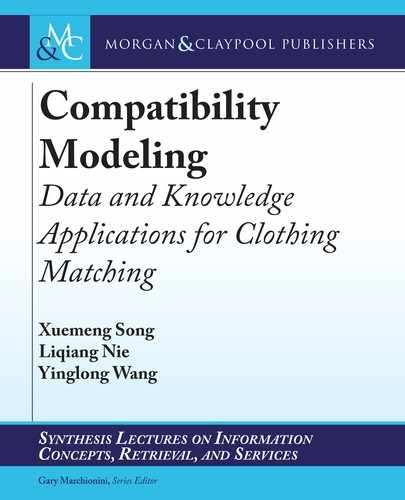30 4. KNOWLEDGE-GUIDED COMPATIBILITY MODELING
plied to solving the visual relationship detection [131], sentence sentiment analysis, and name
entity recognition [98], limited efforts have been dedicated to the fashion domain, which is the
research gap we aim to bridge in this work.
4.3 METHODOLOGY
In this section, we first formulate the research problem, and then present the proposed AKD-
DBPR.
4.3.1 PROBLEM FORMULATION
Similar to Chapter 3, suppose we have a set of tops T D ft
1
; t
2
; : : : ; t
N
t
g and bottoms B D
fb
1
; b
2
; : : : ; b
N
b
g, where N
t
and N
b
denote the total numbers of tops and bottoms, respectively.
For each t
i
(b
i
), we use v
t
i
(v
b
i
) 2 R
D
v
and c
t
i
(c
b
i
) 2 R
D
c
to represent its visual and contextual
embeddings, respectively. D
v
and D
c
denote the dimensions of the corresponding embeddings.
In addition, we have a set of positive top-bottom pairs S D f.t
i
1
; b
j
1
/; .t
i
2
; b
j
2
/; : : : ; .t
i
N
; b
j
N
/g
derived from our Dataset I, where N is the total number of positive pairs. Accordingly, for each
top t
i
, we can derive a set of positive bottoms B
C
i
D fb
j
2 Bj.t
i
; b
j
/ 2 Sg. Meanwhile, we have
a set of rules R D fR
l
g
L
lD1
pertaining to clothing matching, where R
l
is the l-th rule and L
is the total number of rules. We employ R
C
and R
denote the set of positive and negative
rules, respectively. We employ m
ij
to denote the compatibility between top t
i
and bottom b
j
. To
accurately measure m
ij
, we focus on devising a neural compatibility modeling scheme, which is
able to jointly learn from both the specific data samples and general knowledge rules.
4.3.2 DATA-DRIVEN COMPATIBILITY MODELING
Similar to the previous chapter, we assume that there is a latent compatibility space that can
bridge the gap between fashion items from heterogeneous spaces. In such latent space, compat-
ible complementary fashion items are enabled to share high similarity. In particular, we adopt
the pure data-driven neural network to explore the latent compatibility space, due to its recent
compelling success in various machine learning applications.
As previously mentioned that each fashion item can be associated with multiple modalities
(i.e., the visual and contextual modalities), to seamlessly exploit the potential of both modalities
in the compatibility modeling, we employ the multi-layer perceptron (MLP) to model the se-
mantic relation between different modalities of the same fashion items. In particular, we add K
hidden layers over the concatenated vectors of visual and contextual representations as follows:
8
ˆ
ˆ
ˆ
<
ˆ
ˆ
ˆ
:
z
x
i0
D
v
x
i
c
x
i
;
z
x
i1
D s.W
x
1
z
x
i0
C b
x
1
/;
z
x
ik
D s.W
x
k
z
x
i.k1/
C b
x
k
/; k D 2; : : : ; K; x D ft; bg;
(4.1)
..................Content has been hidden....................
You can't read the all page of ebook, please click here login for view all page.
